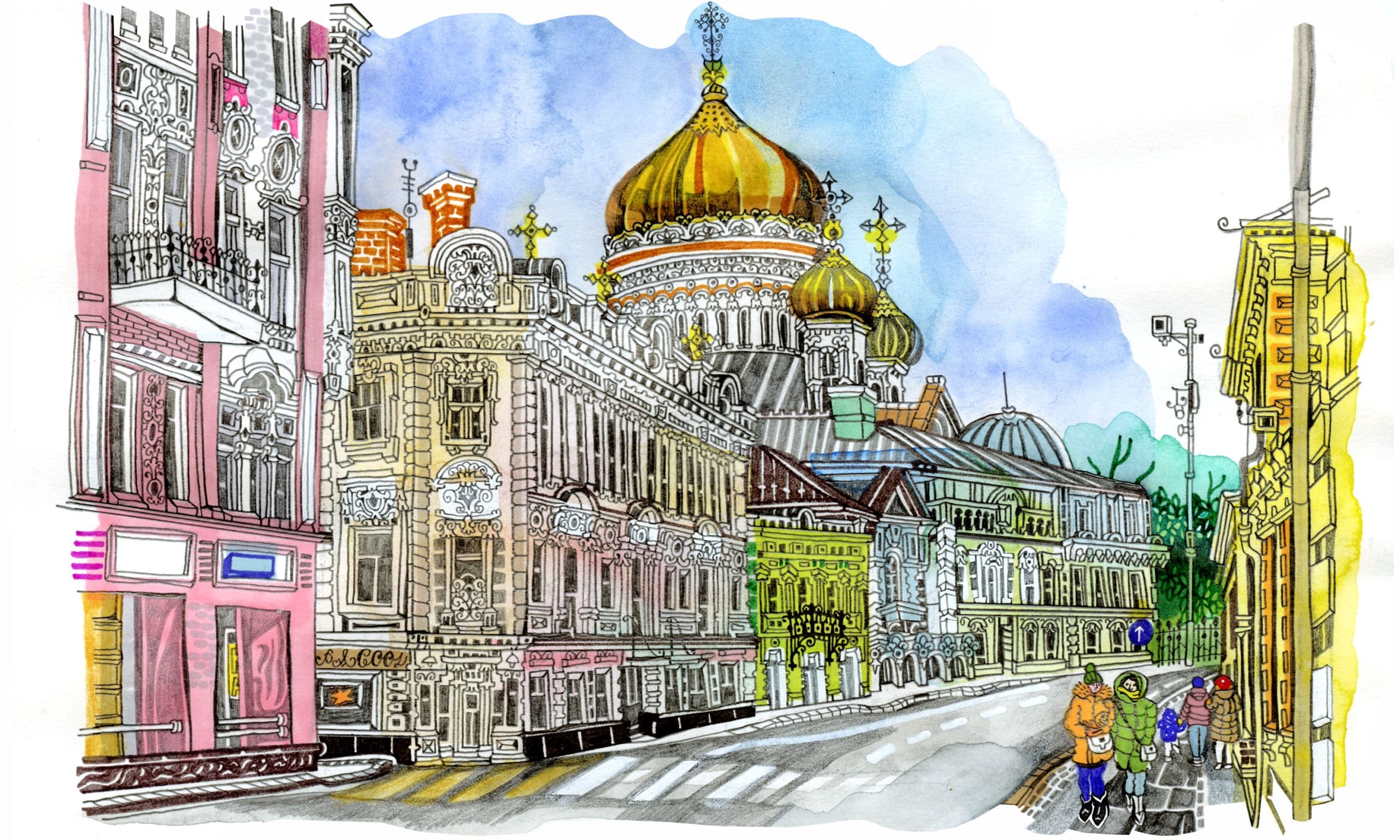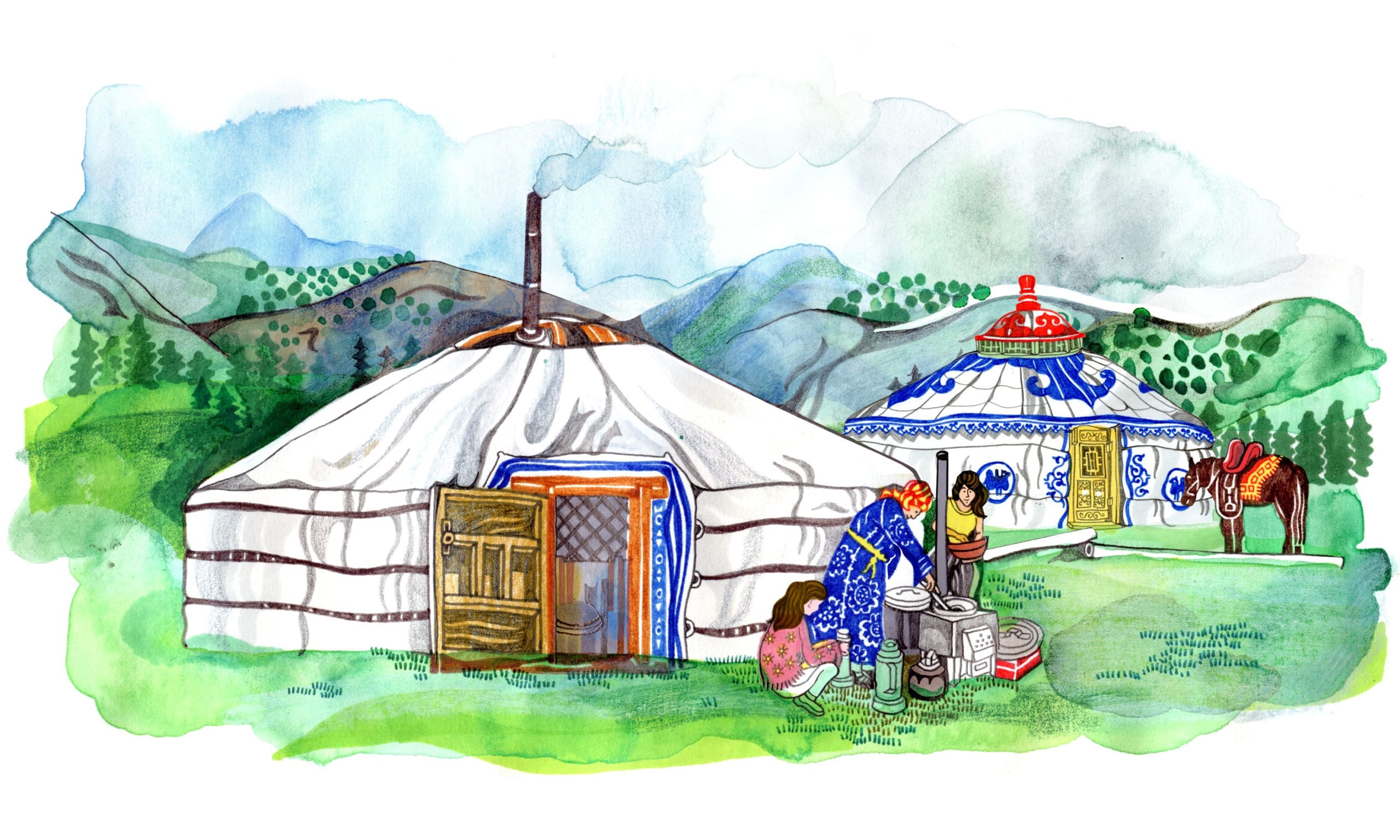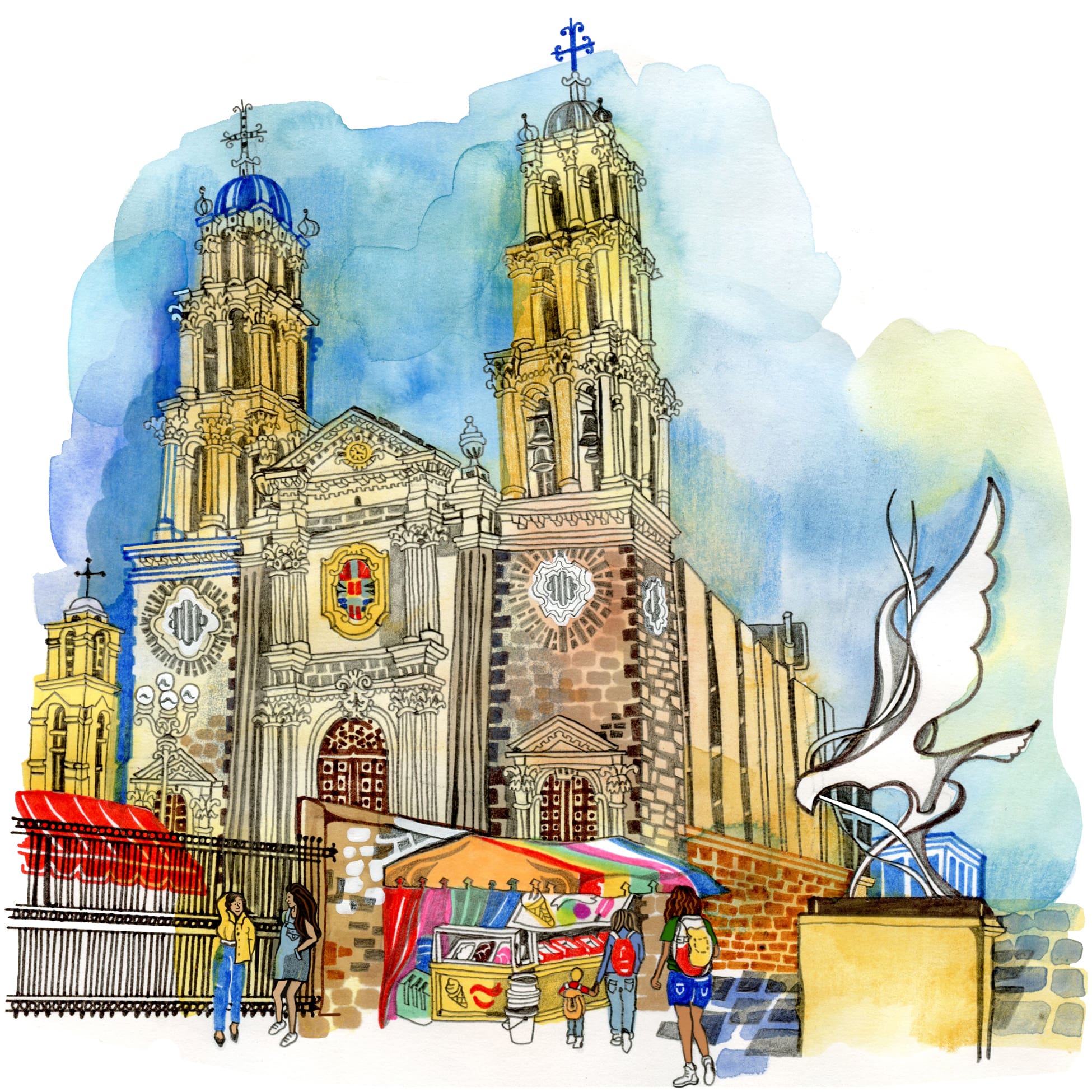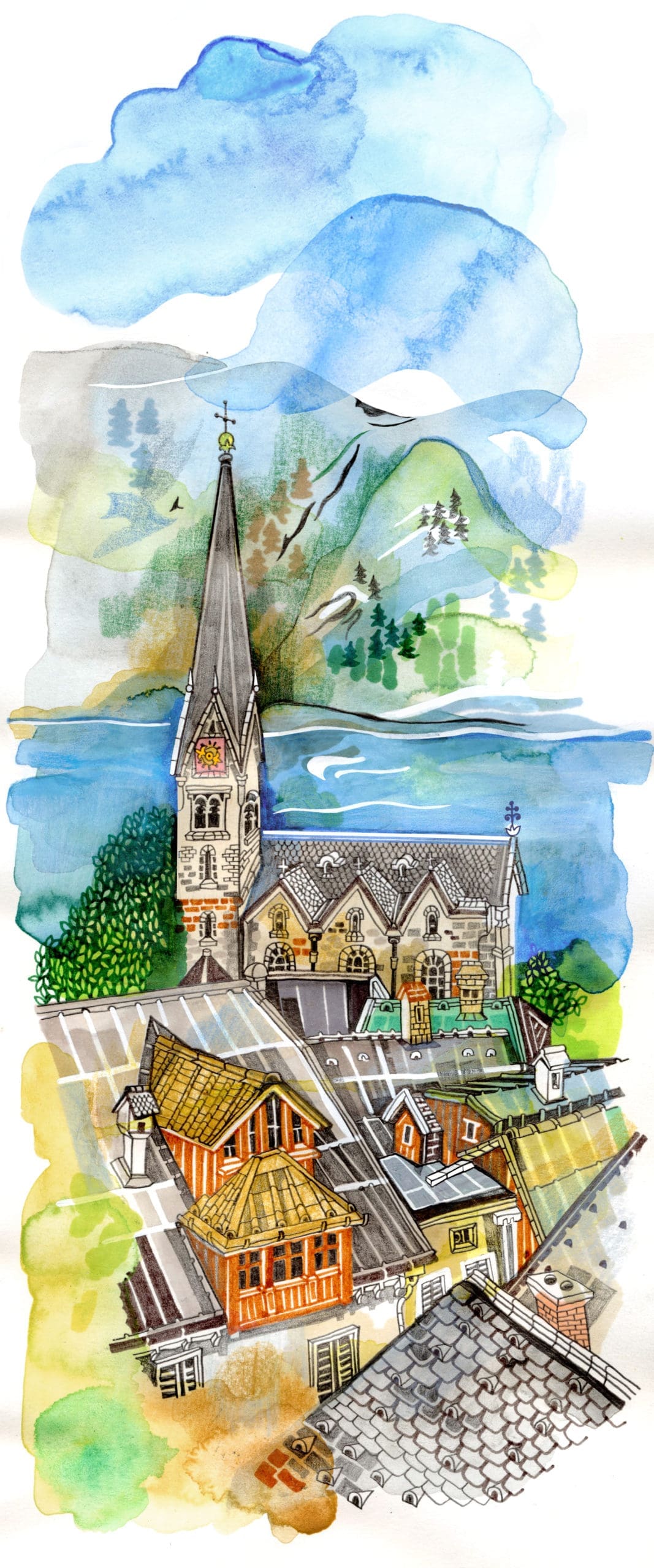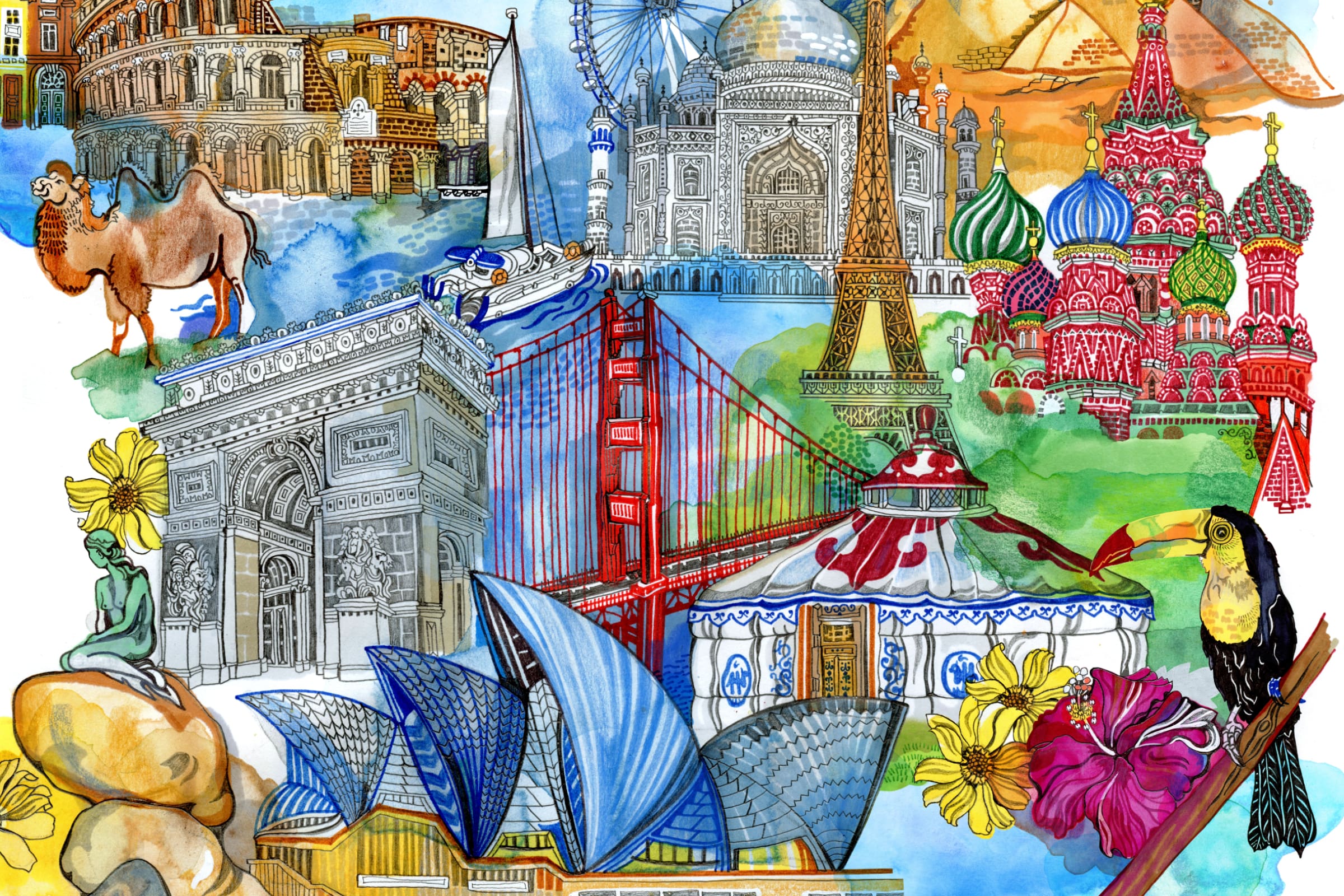
5 World Travelers Share Their Life-Changing Journeys
What makes travel truly transformative? 5 everyday people share the incredible trips that shaped their lives in unimaginable ways.
What makes travel truly transformative? It’s not enough to pack a suitcase, fly halfway around the world and simply exist in a different space. Real change is more intangible, less choreographed and almost never predictable. Our most profound trips can happen by accident. Others are born of tragedy. And sometimes, we don’t even realize the impact an escape has had until we return home. Here, 5 everyday people — a publicist, an entrepreneur, a sailor, a chef and a musician — take us through the journeys that altered their lives in unimaginable ways. Woven throughout their stories, you’ll also find more than a dozen trip ideas to inspire your future travels, from a snowshoeing gastronomy tour of Japan to a musical cruise on the Danube. What revelations await you on your next sojourn? The only way to find out is to take that first step.
Healing on the Trails
Katherine Han, 53
Travel Publicist | Westminster, Colorado
I had a routine mammogram in June 2020 and got my diagnosis that July: cancer. I didn’t know what to expect with the double mastectomy and reconstructive surgery. I’d been so healthy and active up to that point, hiking and trail running. And now my doctors were telling me I might not walk for awhile and I wouldn’t be able to lift my arms above my shoulders. It was scary.
I expected the pain and the physical recovery. But the emotional side, the depression — that’s something you can’t prepare for. The way I got through it was to start walking. Literally, just push myself off the couch and go for a walk, even if it was only 10 minutes.
Each day though, I’d go for a longer and longer walk. In October, my brother and I went hiking at Garden of the Gods in Colorado Springs. The weather was beautiful, the leaves were changing. I was feeling better. But it wasn’t until May 2021 — eight months after my surgery — that I went to Costa Rica.
Las Catalinas is a seaside resort town on the Guanacaste coast, with the Pacific Ocean on one side and tropical rainforest on the other. I had been there for work trips and knew the weather that time of the year was great for trail running, mountain biking and kayaking. I opted to stay for a month.
The first day there, I got up at 5:30 and hit the trails. Some days I’d go longer, others shorter or hillier, but every morning I’d go. I was testing myself in a way I hadn’t since my surgery.
Las Catalinas has 26 miles of amazing trails. One minute you’re running along the cliffside with a sheer drop straight into the ocean, then suddenly you’re running through the jungle with howler monkeys, snakes and colorful birds. I usually listen to music or a podcast when running at home, but down there, I just listened to nature.
After my run, I’d go to an outdoor gym and alternate between cardio and weight training. I don’t really lift weights, but I was trying to build back my upper body strength. I paddleboarded, too — my first attempt since the mastectomy. At first I was like, No way can I do that. But a guide helped push me out and as soon as a wave would pass, I’d get on the board and go. My mindset went from zero to You can do this.
When I told a trainer that I’d recently had a double mastectomy, he said, “I never would have guessed.” What a vote of confidence! People didn’t even know I was sick. And that’s the thing: Who you were before something like this is not who you are now, but that doesn’t mean the person I am now can’t be just as strong — or even stronger.
On my last day in Las Catalinas, I ran 13 miles. I’d never run that far in my life. I wanted to stop so many times, but I wouldn’t let myself. I just kept going until I finished. It was the turning point in my recovery, when I realized my mind and body could do anything. I was in a fragile emotional state when I arrived in Costa Rica, but this trip showed me I don’t have to be defined by my cancer. I’m not scared anymore.
Life-Changing Wellness Trips
Greek Yoga
The weeklong Nefeli Nine Retreat in Dikastika, Greece, has everything you need for a detox: morning hikes through the countryside, high-intensity afternoon workouts, daily yoga sessions, nutritious organic meals, soothing massages and plenty of poolside lounging. June, September, October and November 2022.
Korean Spas
When you’re not tucking into healthy temple cuisine or roasting your jet-lagged bones in a jjimjilbang (bathhouse) in Seoul, Ker & Downey’s eight-day Korean Wellness Retreat has you bouncing down to Jeju, a retreat island known for its mineral-rich waters. There, you’ll hike the dormant Hallasan volcano, tour herbal farms and tea plantations, and indulge in a bit of therapeutic forest bathing. Year-round departures.
California Escapism
Opening in early 2022 in Rancho Mirage, California, the 230-acre Sensei Porcupine Creek is an ultra luxe wellness resort with a cutting-edge diagnostic center, world-class golf course and tennis facilities, yoga and fitness pavilions, and a picturesque spa garden for facials and bodywork. In other words: a true desert oasis to unwind and reset. Year-round bookings.
Rediscovering a Place of Beauty
Maria Karr, 34
Rumore Beauty Founder and CEO | New York City
I grew up in Siberia in the early nineties. Russia was rebuilding itself — politically, economically and philosophically — and resources were scarce.
Russian women are known around the world for their looks, but the idea of vanity or a beauty routine didn’t exist back then. Imported cosmetics were hard to come by and super expensive, and whatever government-owned brands existed — like heavy creams in reusable aluminum packaging — were not sexy. But people made the most of what they had, venturing into the forest to gather natural ingredients like herbs, berries and mushrooms for home treatments.
By the time I was a teenager, the world started opening up. Door-to-door beauty brands like Avon and Oriflame were appearing on the market. I even worked a brief stint for Oriflame when I was 14, going from classmate to classmate with sales catalogs.
I came to the United States in 2007 as an exchange student. I lived with a family in Staten Island, and one of my first memories was walking down the street and hearing five languages in a matter of minutes. I’d never heard a language other than English or Russian spoken in real life. It was remarkable.
I stayed here for college then went to work in the beauty and entertainment industries. In America, Russia is often seen as the bad guy because of its politics. And then there are the stereotypes about vodka and bears. I wanted nothing more than to assimilate and just be seen as a valid citizen of American society.
Four years ago, I got into running. After completing my first marathon in New York City in 2018, I decided I wanted to go international. Berlin was my first choice, but it was ridiculously expensive. So I started looking into other options and came across Russia. I hadn’t been to my home country in more than 10 years, but I decided to sign up for the Moscow Marathon in September 2019.
My first morning there, I walked around Moscow just absorbing everything. There was this overwhelming feeling like, This is all mine. This is who I am. These are my roots. I remember going to Red Square and feeling awed by the beauty. I felt so proud. It was then that I realized I had been wrong to deny my identity all that time.
As a beauty professional, I couldn’t resist the urge to shop in the Russian stores. I discovered a lot of brands I’d never heard of before. Mi&Ko, made in Kirov, uses all-glass packaging for its 100% natural, sustainable skincare products. Botavikos makes vegan cleansers, scrubs, serums and masks; the Anti-Stress Serum with sea buckthorn and niacinamide is a true gem. That’s when I thought, How come no one knows about Russian beauty products? In my entire career, I’ve never seen any in the United States. That day, I promised myself I’d find a way to connect my career in New York City with my Russian heritage.
Last February, I launched Rumore Beauty, the first and only e-commerce platform dedicated to the discovery of Russian beauty brands. It’s going really well so far, but the idea is still very new. When I first started representing Korean beauty brands back in 2014, it was like the Wild West; Korean beauty wasn’t mainstream at all and Americans thought face masks were weird. Now, look at it: Korean beauty is everywhere. I’m hoping Russian beauty will also be very big one day and that we’ll be the ones to introduce it.
I’ve always prided myself on being a world traveler, but going back to my home country never felt as exciting as going on safari in Africa or climbing Machu Picchu. Yet it was such an important trip for me to reconnect with my roots and understand that my Russian background isn’t something negative that I have to hide. That trip made me realize it’s OK to be an immigrant. Like a puzzle, my culture, language and love of beauty just came together.
Life-Changing Style Trips
Tuscan Fashion
For the voguish Italophile, nothing touches Couturista Travel’s six-day tour of Tuscany, granting VIP access to private ateliers, artisan show rooms, luxury retail outposts, pop-up shops, and collections at the Pitti Palace Costume Gallery and Salvatore Ferragamo Museum in Florence. Year-round departures.
Guatemalan Crafts
Tia Stephanie’s 10-day tour of the Guatemalan Highlands goes deep on Mayan textiles and traditions. See the handiwork at the Ixchel Museum in Guatemala City come alive at the Chichicastenango market, where women sell colorful jaspe (ikat) and cortes (wrap skirts). Then experience back-strap weaving in Nebaj and foot-pedal looming in Totonicapán. Year-round departures.
Moroccan Artistry
If it’s decorative marquetry boxes, ottoman poufs and boucherouite rugs you’re after, this 13-day tour of Casablanca, Fez, Rabat, Essaouira, Marrakesh and the Atlas Mountains has all your interior design needs covered. Local scouts will lead you through the medieval medinas, where you’ll meet artisans specializing in zellige tilework, leather tanning, Arabic calligraphy and more. Year-round departures.
Riding to Recovery
James Kell, 47
Sailing Virgins Founder | Canberra, Australia
My cousin Tom died in an avalanche in 2008. He was skiing in the Australian backcountry with his brother Pete when a cornice of snow just exploded, taking him with it. Pete dropped straight into the chute behind the avalanche and was digging madly for hours. But my cousin was buried 10 feet under.
Tom was 21 years old, perfectly healthy, an up-and-comer in the regional rugby union. The loss was just terrible, especially for Pete.
At Tom’s funeral, me, Pete and another cousin of ours, Gus, started asking ourselves, Why do we do what we do? Our family has always been adventurous; it’s part of our identity. After a couple more beers, we agreed to have an adventure in Tom’s honor.
The only rule was: At every decision point, choose the harder option. We couldn’t think of any place more outlandish than Mongolia in winter. To make the trip even harder, we decided we wouldn’t use engines for transport or book any accommodations in advance.
In 2010, Gus and Pete started the trip at the Russian border, where they hired a Mongolian guide called Temujin, named after Genghis Khan, and purchased some horses. I flew into Ulaanbaatar a few weeks later, and they picked me up from the airport on horseback.
For the next three weeks, we rode 14 miles a day across lunar landscapes, stopping in the afternoon to find a ger — a Mongolian-style yurt — to sleep in. Can you imagine? Here come these three white guys, dressed in head-to-toe down jackets and pants like Michelin Men. We must have looked like aliens, but the Mongolians were totally unfazed. There was never any astonishment, no fakery. We’d just sit with the men on one side of the ger and the women would sit on the other. They’d serve us simple but tasty noodles and soups, foods that fill you with energy when you’re freezing on the steppe. They never asked for money, though we’d of course pay them. It was just pure hospitality.
When the wind got up, we’d kite surf. It was a little reckless but also exhilarating. We got battered and bruised, but we never lost a glove. In -50 degrees, that’s when you’re in real trouble.
From Ulaanbaatar, we went south to the Gobi Desert, where we switched from horses to camels. The plan was to cross over to China, but Temujin had appendicitis. We rode back to Ulaanbaatar, and the hospital operated on him that day. We’d made it just in the nick of time.
Traveling by horseback made me realize just how big the world really is. It was slow and uncomfortable, but we finally had time to think. From dusk to dawn, we were in our own heads, sometimes riding an hour or two without talking. There’s no Starbucks out there. No Internet. No distractions. And Tom had died just two years earlier, so it was still very raw.
There were some tough days, but I would argue that the nomads are as content — if not more so — than your average Westerner. Our constant quest for better, faster, cheaper does not make us happier. I was working at a corporation before our Mongolia adventure. Afterward, I hopped off the rat race. I knew that wasn’t what I wanted to be doing with my life. This trip was validation.
Now, I’m the owner of my own adventure travel company. A lot of people from the corporate world take our sailing courses, and even though they’re only one week, it’s enough time for them to ask the big questions about life. There’s no utopia, so forget about that. But there are other alternatives. The point is to step back and dream.
Life-Changing Adventure Trips
Alaskan Rafting
Raft 160 miles down the raging Alsek River, navigating icebergs and exhilarating class II, III and IV rapids between remote Haines Junction in Yukon, Canada, and Yakutat, Alaska. MT Sobek’s 13-day crossing is not for the faint of heart: The expedition includes riverside camping, a helicopter portage over a dangerous canyon and — with any luck — bear encounters. July 2022.
Irish Hiking
Summit Ireland’s highest peak, Carrauntoohil, on this weeklong Wilderness Ireland trek through the Dingle and Iveragh peninsulas. The mountainous route covers up to nine miles a day, showcasing panoramic views of MacGillycuddy’s Reeks, Brandon Bay and the Ring of Kerry. Though you may find the trails quite rugged, the overnight accommodations are pure comfort. April and May 2022.
Pakistani Off-Roading
Wild Frontiers’ 15-day Hindu Kush loop from Islamabad journeys to the heart of remote Northern Pakistan. En route, you’ll tour Buddhist sites in the formerly off-limits Swat Valley, sleep in the home of a Chitral prince, hobnob with a Kalash chief, catch a game of mountain polo and shop in a Pashtun bazaar. May, August and September 2022.
Charting an Old Frontier
The Borderlands
Pati Jinich, 49
Chef and TV Host | Washington, D.C.
I was born and raised in Mexico City, but it wasn’t until my husband and I moved to the United States in 1997 that I became nostalgic for my home country. Though I was an awful cook, I started going to Latino grocery stores to find Mexican ingredients. And the more Mexicans I met from the diaspora, the more I realized how little I knew about my own country.
I was working as a policy analyst in a think tank, feeling bored and miserable. All I could think about was food and how my identity as a Mexican living in America only made sense in the kitchen. I started teaching Mexican cooking classes on the side and, little by little, made it my central thing. Here we are, a decade later, and Pati’s Mexican Table has been on PBS for 10 seasons.
The show is part travelogue, part cooking series. We visit a different region of Mexico in each episode then I return to my kitchen to show viewers how they can recreate those flavors at home. When you have two home countries you adore, you want to do right by both. It’s that dichotomy that inspired my latest PBS special, La Frontera, which aired last fall.
While there are certainly preconceptions about Mexico, there are even more about the Borderlands. It’s seen as this crime-ridden place where Americans go to get trashed. Though I had researched a lot about the history and politics of the region, it wasn’t until I started meeting the communities actually living along the U.S.-Mexico border that I began to understand just how unique it is. It’s a world caught in between — neither here nor there — and it’s fascinating.
We filmed La Frontera for two and a half weeks last May and June. We wanted to cover the entire length of the border, but with COVID restrictions, we focused on Texas — specifically El Paso, Ciudad Juárez, Laredo, Nuevo Laredo, McAllen and Brownsville.
People think of the Borderlands as mostly Mexicans and Americans, but there are Mexicans who’ve been in the United States for centuries as well as Americans living on the south side of the border. There’s a big Syrian community in El Paso and Japanese American cattle farmers raising Akaushi beef in the Rio Grande Valley. There are Haitians, Cubans, Chinese, Muslims, crypto-Jews — all these micro universes. And they’re fed up with being portrayed so narrowly in the media. The people in these towns are hard-working, adaptable and resilient, because they have no other choice.
The border towns shocked and surprised me. El Paso has a thriving artist community, and the people there tell their stories through murals and music. It’s like a living, breathing museum. Brownsville has SpaceX, so there’s this gigantic space shuttle on a beach with kids playing and people fishing — all these clashing things coming together. And Big Bend National Park is just jaw-droppingly beautiful. Even the border wall itself, which is loved by so many and hated by others, looks like a sculpture from certain angles.
The food, of course, blew my mind. Tex-Mex is criticized as this bastardization of Mexican, but it’s really its own regional cuisine with so many variations. In the Rio Grande Valley, I tried raspados — shaved ice gone wild, topped with all sorts of sweet and sour things — for the first time. In Marfa, this quirky little town that feels like a movie set, I tasted some of the best barbecue of my life at Convenience West.
If you like history, if you like art, if you like eating, if you like intense experiences, if you like nature — the Borderlands is a fascinating region. It has so much to offer, yet it’s so misjudged. And the farther you get from the Borderlands, the bigger the misconceptions get. The sister cities on either side of the border have far more in common with each other than they do with New York City or Mexico City.
As a Mexican who now lives in the United States, I have spent decades treading between these two countries I call home. What I found when people opened their homes and lives to me was not a place where two countries clash, but a fascinating, rich, diverse universe with possibilities that cannot exist anywhere else.
Life-Changing Culinary Trips
Peruvian Fare
Belmond has really outdone itself with this 11-day foodie adventure through Peru. High points include shopping Lima’s Surquillo Market with a chef, dining aboard the fabled Hiram Bingham train as it descends Machu Picchu and learning how to stir up the perfect chilcano in Colca Valley. Top-notch accommodations include the five-star Belmond Sanctuary Lodge at Machu Picchu. Year-round departures.
Slovenian Wine
Eat and drink your way along the Slovenian-Italian border with celebrated chef Ana Roš of Hiša Franko. Prior’s exclusive five-night culinary and natural wine itinerary stops at castles, churches, and a clutch of organic and biodynamic vineyards; it even weaves in a hands-on foraging experience in the idyllic Soča Valley. September 2022.
Japanese Gastronomy
Follow in the footsteps of samurai warriors on Walk Japan’s five-day snowshoeing tour through rural Aizu. Part of the outfitter’s Onsen Gastronomy series, the journey balances luxuriating soaks at thermal hot springs with tours of sake breweries and deep dives on soba noodles and delicate Japanese sweets. December to March.
Awakening My Inner Musician
Natalia “Saw Lady” Paruz, 40
Professional Sawist | New York City
My mother tricked me into dancing when I was 10 years old. She took me to see the film Movie Movie, where one of the characters is a dancer. When we left the theater, I said, “Wow! I want to learn how to dance.” That’s how I got hooked.
I started with tap and ballet but eventually discovered contemporary dance. I was a trainee with the storied Martha Graham Dance Company. Her technique went against the dance conventions of the time, telling dramatic stories through movement.
By 2000, dance was my life. I was at the studio every day — taking classes, rehearsing, performing. Then one day as I was crossing Central Park South, I got hit by a car. The driver stuck his head out and asked if I was OK. I was in shock, so I said yeah and he took off. Some nice people picked me up from the street and carried me to the sidewalk, then an ambulance rushed me to the hospital. It wasn’t until the next day that I really started to feel the pain.
I suffered an injury to my upper spine. I could walk, I could jog, but I couldn’t dance because I’d lost mobility in my neck. I couldn’t even turn my head sideways. And leaning backward? Forget it.
I tried physical therapy, acupuncture, you name it — there was no reversing the situation. I was 20 years old and all my ambitions, dreams and plans were changed in a snap. The day after the accident, I was supposed to have a callback audition for the Radio City Rockettes. Needless to say, I couldn’t go.
I was living with my parents in Queens at the time, and they saw how devastated I was. To cheer me up, they planned a trip to Austria in 2001. My favorite movie as a kid was The Sound of Music, so they thought I might like to see where it was filmed. A good distraction, you know?
The trip was amazing. In Innsbruck, we went to a variety show for tourists — just a hodgepodge of Austrian folklore, singing and dancing. Then suddenly, this guy comes onstage with a carpenter’s handsaw and starts playing it. I was mesmerized. The sound was so beautiful: surreal, angelic, singsongy. And even though he was sitting on a chair, the technique involved a lot of movement. The steel blade bends as you play it with a bow, creating wave-like shapes in the air. It was very visual — dance in a different form.
Watching this act, I felt a fire inside me, like how I used to feel about dance. After the show, I went backstage to talk to the saw player and asked if he would give me a lesson. He said no, but advised me to imitate what I saw him do onstage. He wasn’t trying to be mean; this art form is traditionally self-taught.
I had some musical teachings growing up — my mother taught me piano and I took guitar lessons — but I didn’t continue on with it. When I got back to New York, I borrowed a saw from a friend and tried doing what I saw onstage. I could make sounds, but the saw was rusty and only played six notes. So I went to a local hardware store and tried out all the saws. Furious, the shop owner came to the aisle and was like, “What is this noise?!” When I explained what I was doing, he looked at me like I fell down from Mars. I ended up purchasing an expensive saw, so he was happy, and sure enough, it had an octave and a half of notes on it.
When I first started playing, I was learning basic melodies like “Twinkle, Twinkle, Little Star.” This evolved into Schubert’s “Ave Maria” and George Gershwin’s “Summertime.” Eventually, I developed my own technique and started commissioning original music. It was the first time since the accident that I felt passionate about something.
I had no intention of making this my profession, but the walls in New York apartments are thin. Sound carries. Unbeknownst to me, a neighbor told a community center that I was learning this cool art form. They invited me to play for their seniors. After just a few months, my phone started ringing with invitations. But it was busking that got me the most gigs — weddings, festivals, corporate events — as well as my nickname, “Saw Lady.”
Today, I’m a professional sawist, performing at Carnegie Hall, Lincoln Center and Madison Square Garden. You know the saying “When life gives you lemons, make lemonade”? For me, the car accident was the lemons. Austria turned it into lemonade.
Life-Changing Culture Trips
European Classics
If you’re a fan of Strauss, Schubert, Liszt, Bartók and Haydn, you’ll find plenty to love on Tauck’s 12-day, five-country musical cruise along the Danube River. Among the highlights: stopping at a storied Slovenian opera house, observing a recital of Europe’s largest pipe organ in Passau, Germany, and chatting with a professor at Salzburg’s Mozarteum University. April, August and October 2022.
Arabian Art
The sheer glitziness of the United Arab Emirates tends to overshadow the peninsula’s more artistic leanings. This nine-day trip from Remote Lands sets the record straight — visiting established and up-and-coming galleries, community art spaces, and studios in Dubai, Abu Dhabi, Sharjah and the vibrant port city of Muscat, Oman. Year-round departures.
Low-Country Culture
Smithsonian Journeys’ six-day tour of Charleston and Savannah digs into the complicated racial history of the South’s most iconic haunts. Visit one of the oldest African Methodist Episcopal churches in the country, learn the real stories behind those grand plantation homes, and engross yourself in the unique cultural and linguistic heritage of the Gullah Geechee community on Hilton Head Island. March and November 2022.
Read this article as it appears in the magazine.


